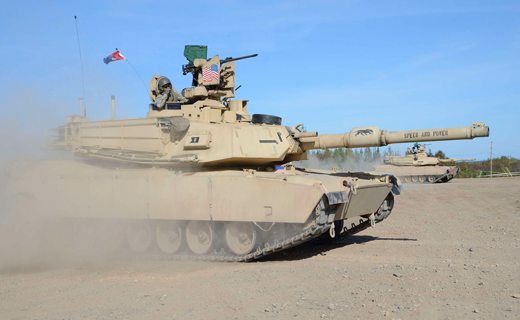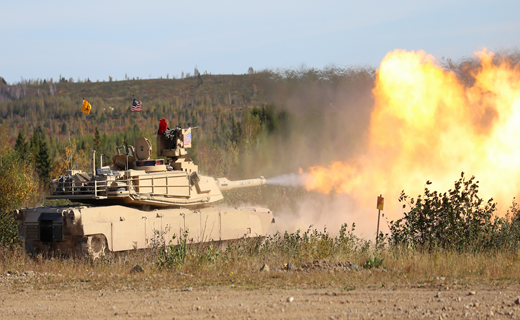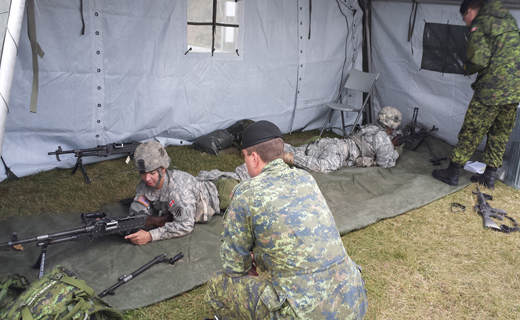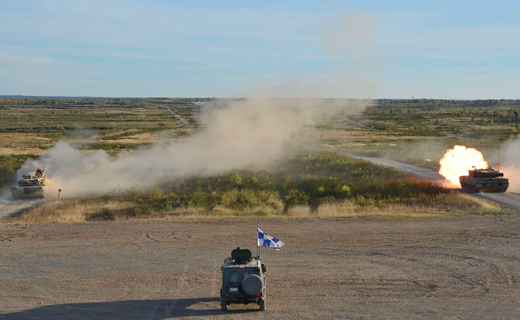Canadian Exercise Worthington Challenge: Opportunities in Theater-Security Cooperation




Theater-security-cooperation missions provide the opportunity for a renewed focus on competition and partnership as a means of assessing Soldier readiness, building esprit de corps and maintaining interoperability among units and countries. The 3rd Armored Brigade Combat Team (ABCT), 3rd Infantry Division, sent two M1A2 crews and two M2A3 crews to Canada’s Exercise Worthington Challenge – hosted at 5th Canadian Division Support Base in Gagetown, New Brunswick, Sept. 29-Oct. 2, 2014. Worthington Challenge, similar to the U.S. Army’s Sullivan and Gainey cups, is a competition among the best armored vehicle crews from across the Canadian Army.
The 3rd ABCT’s regional alignment with U.S. Northern Command resulted in its selection to send teams to compete in the challenge. SFC James Grider, commander of the winning tank crew from the Sullivan Cup, 2-69 Armored Regiment, selected SFC Michael Deleon as wingman for the competition.
The 3-1 Cavalry hosted a gunnery shoot-off to select the two best M2A3 crews from the brigade. Each unit from within the brigade sent top-performing crews from gunnery that would best represent the United States during an international competition. Crews commanded by SSG Matthew Doty and SGT Aaron Savage from 3-1 Cavalry and 1-15 Infantry, respectively, were selected to participate in the competition’s 25mm division.
Background
This year was the Royal Canadian Armoured Corps School’s (RCACS) third iteration of the modern Exercise Worthington Challenge and the first time the U.S. Army sent teams to participate since 2001. In 2012, the exercise was purely a tank-gunnery competition in which Canadian Regular Force armored units sent one Leopard II section each. The competition was expanded in 2013 to include units from the Canadian Army Combat Training Center and 5th Canadian Division Support Base Gagetown. The 2013 challenge grew further to include a 25mm category for Canadian light armored vehicles (LAV); however, the exercise was still based entirely on armored-fighting-vehicle (AFV) gunnery.
This year’s iteration of Worthington Challenge was a major departure from previous competitions in its expansion to include all four Canadian Army divisions, teams from the U.S. Army and the 25mm category’s opening to infantry and engineer LAV crews. The competition format also changed to include a variety of critical Soldier and AFV crew skill tasks in addition to direct-fire gunnery. In the spirit of expanding the competition to include other members of the American, British, Canadian, Australian and New Zealand armies’ programs, observers from the U.S. Marine Corps, British and Australian armies also attended in hopes of sending teams to compete in the future.
The RCACS commandant, LTC John Andrews, wrote that his “primary intent in developing and executing Exercise Worthington Challenge is to enhance unit focus on AFV-mounted direct-fire gunnery, crew and individual soldier skills across the Canadian Army.” Of particular note, among the competition’s secondary goals were the attempt to promote esprit de corps and foster camaraderie; enable an assessment of the state of the army’s gunnery skills; and “foster relations and interoperability with Allied partners.” The U.S. 3rd Infantry Division crews who participated can attest to the accomplishment of the ancillary objectives through participation in thorough after-action reviews (AAR), shared field and social time with Canadian Soldiers, and execution of combined-gunnery runs with American and Canadian vehicles.
Stands
The competition itself spanned four days, during which teams, grouped by divisions, rotated through each of four separate daylong “stands” in a round-robin fashion. Tanks competed as sections, whereas the 25mm crews competed as single vehicles due to engineer and infantry task organization. The tank section from 2-69 Armored Regiment was paired with Canada’s 12th Armoured Regiment; the M2A3 crew from 3-1 Cavalry was paired with the Royal Canadian Dragoons; and the M2A3 crew from 1-15 Infantry was paired with Princess Patricia’s Canadian Light Infantry Regiment.
The four stands in which teams were assessed were AFV identification (AFVID)/range estimation/all-arms call for fire (AACFF), the driving and maintenance challenge, the “march and shoot” stand and live-fire gunnery.
Teams performed the AFVID/range estimation/AACFF stand by rotating through each of the three substations by crew. In a departure from the norm, crews did not test AFVID by watching a slide show. For the first portion of AFVID, crewmembers crawled into a simulated hide site and watched footage of vehicles on a screen while battle noise played in the background. Portions of the vehicles were blacked out to make identification more challenging. The second portion involved crews identifying vehicles from the turret of their vehicle.
“It was nice to conduct vehicle identification in a setting other than a classroom,” commented Grider. “[The Canadians] made it challenging. The test made you focus on something other than a gun tube or turret. You really had to look at the fine details to properly identify the vehicle.”
Competitors tested range estimation with binoculars from a foxhole in the same stand; however, targets were not to scale. According to Grider, “The lack of scaled targets forced individuals to rely solely on pure estimation rather than formal means, such as the ‘width over radians times mils’ method.”
Finally, the AACFF provided a standard test to ensure competitors knew the basic tasks. RCACS planners provided a breath of fresh air in a traditionally dry event by presenting unique challenges and testing formats not commonly seen in similar training today.
Crews started the driving and maintenance challenge by sprinting to a staged vehicle about 100 meters away while wearing their fighting-load carrier (FLC), Advanced Combat Helmet (ACH) and protective masks at their sides. For time, tank and Bradley crews changed a road wheel, while LAV crews changed a tire. Crews then continued to run to a first-aid station, where basic skills were tested, and they were required to carry a weighted litter. The stand finished with each crew negotiating a closed-circuit driving course that had a variety of challenging obstacles ranging from steep dropoffs to severe washboards.
“The driving and maintenance stand was particularly demanding, as it combined elements of fitness, application of first aid, conducting maintenance and obstacle driving on a closed circuit into one single event,” said MAJ Sylvain Gagnon, RCACS’ chief instructor. “This offered a variety of challenges, creating a complex environment where competitors were forced to adapt quickly.”
The “march and shoot” tested crews’ teamwork, physical fitness and mastery of small-arms marksmanship. Competitors began the day’s stand by negotiating the RCACS obstacle course as crews. Soldiers executed a variety of high and low obstacles while wearing FLC, ACH and protective mask on their hips, and while carrying a dummy rifle. The best crews used teamwork to get through challenging obstacles quickly.
Upon completion of the obstacle course, crews tested on the Canadian C6 machine gun (M240B equivalent). Soldiers demonstrated proficiency in clearing, disassembling and reassembling, then simulated loading and reducing stoppages on the C6.
Crews then immediately began a timed foot movement of more than four miles, largely over gravel roads, to a small-arms range. Individuals received their assigned rifle and pistol and were tested on proficiency in immediate-action drills before they received ammunition. Competitors then zeroed rifles and moved to the stress shoot. Crews conducted a controlled, but timed, run through a range requiring sprints, firing from a variety of positions, changing weapons from rifle to pistol and back again, and carrying a casualty.
Doty said he found the use of iron sights rather than optics to be particularly refreshing as a test of basic shooting skills. The variety of target shapes and sizes, coupled with a strict engagement order, proved to be a difficult test for even the best marksmen.
The fourth stand, live-fire gunnery, was constructed with two scenarios: one for a tank section and one for a single LAV/Bradley crew. Each section/crew executed the range twice during its assigned day. The range, executed in several bounds, presented unheated popup and moving-vehicle targets, as well as very small metal “falling plates” as troop targets.
“Our aim was to have a dynamic range that centered on fire team/crew skills,” said CPT Michael Bastien about developing the gunnery scenario. Bastien serves as the Canadian Army’s instructor-gunnery (master gunner) team leader. “We wanted to incorporate minimal supervision to enable communication among the fire team and offer a complex array that forced crews to use their skills. Targetry was aimed with multiple presentations and timed exposures focusing on acquisition skills and quick engagements, both main and secondary armament.”
The reliance on daysights and the naked eye rather than thermals, coupled with rapidly changing and varied targetry, presented an incredible challenge for all participants. “I really enjoyed the higher speeds needed during the runs; it helped challenge the crew and show the capabilities of the Bradley,” said Doty.
After-action
While not part of the scoring, it was evident in the tower that crews with the best radio communication practices largely scored better than sections that did not use the radio. The tank sections representing 3rd Infantry Division and RCACS received high praise for working effectively as teams. Bastien and his Army instructor-gunnery (AIG) personnel conducted thorough AARs with sections and crews at the conclusion of their battle runs to ensure lessons-learned were both imparted on competitors and recorded for later use.
Event cadre updated the scoreboard as teams completed events; however, there was still no clear winner going into the final day, as the round-robin format meant that all four “stands” had teams executing them. The tank section from 2-69 Armored Regiment placed third out of five teams in the tank division, and 1-15 Infantry placed fourth and 3-1 Cavalry placed first out of 14 teams in the 25mm division. The competition was fierce, with teams having been thoroughly assessed on gunnery, physical fitness and a variety of Soldier skills.
Not wanting to let the opportunity pass by, American and Canadian crews executed a combined battle run immediately before the awards ceremony. Our M2A3s conducted a full battle run with Canadian LAVs with outstanding results. The 2-69 Armored Regiment’s M1A2s then paired up with Leopard IIs in a devastating demonstration of Allied firepower.
“The last battle run we conducted with a Canadian-American troop was a perfect example of our two armies’ ability to interoperate,” Andrews commented.
RCACS capitalized on regimental attendance at Exercise Worthington Challenge by conducting an AIG conference the day after the competition’s conclusion. AIGs came together to share information on a variety of topics, including their army’s testing and fielding of future equipment, simulations programs and updates on the future military budget. The 3rd ABCT master gunners on the trip – SFC Patrick Smith, Grider, Deleon and Doty – attended the conference at RCACS’ invitation. Smith, 3rd ABCT’s master gunner, briefed attendees on the Bradley Fighting Vehicle and programs to develop replacements. The American noncommissioned officers’ attendance led to arrangements for Deleon to attend the Canadian AIG course as part of our continued partnership.
As for the general experience of traveling to Canada, our allies treated our Soldiers as honored guests. RCACS personnel assisted 3rd ABCT, 3rd Infantry Division, in planning support for our reception, participation and return with the greatest of care. The planning began well before our arrival with detailed coordination for support requirements and ensuring 3rd Infantry Division had information about the competition itself. Most importantly, the Canadian Soldiers with whom our crews worked, competed and socialized were extremely welcoming.
“The entire exercise was extremely well thought out and professionally and smoothly run,” summarized Grider. “The tasks we conducted related directly to the profession of mounted warfare. It was a challenging and thoroughly enjoyable competition that did an excellent job of pointing out strengths and weaknesses in our training while building international camaraderie.”
The incredible detail RCACS invested in planning paid dividends in a truly first-class and highly challenging competition. American and Canadian Soldiers were afforded the opportunity to build relationships both on- and off-duty; put their skills to the test against each other; share tactics, techniques and procedures; and demonstrate our forces’ interoperability in a tactical environment. In an environment of slowing deployments, TSC missions oriented on competition and partnered training will continue to provide our Soldiers with outstanding opportunities to work with partnered nations. We look forward to more exchanges with our close allies to the north in future Exercises Worthington Challenge and as they participate in the Sullivan and Gainey cups in the United States.
 email
email print
print